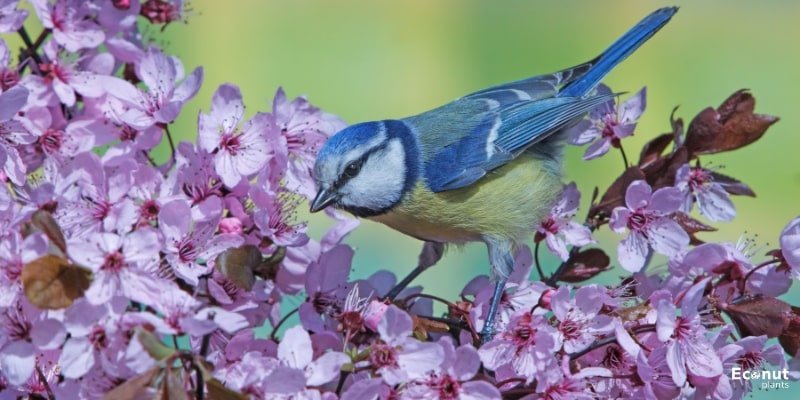When incorporated into a landscape, purple flowers, and foliage plants create a calming impact. Purple flowers conjure wealth and grace in addition to their hue, which has traditionally been associated with royalty.
A beautiful accent to any garden or landscape is planted with purple blooms and green leaves. These are our top 25 purple-flowering Trees, which can enhance your garden with lovely colors.
1. Purple Robe Locust

Scientific Name: Robinia Purple Robe
Locust trees are amazing for wildlife because they may grow to be as tall as 30 to 40 feet, which is ideal for bees, animals, and birds. Their ability to fix nitrogen and minimize erosion makes them useful for any area. They are excellent for reclaiming ground because of their rapid growth and ease of propagation.
You won’t have to worry about them spreading if you plant them and keep the suckers under control. Additionally, the Purple Robe Locust’s blossoms are edible, much like those of the Black Locust Tree, so feel free to boil or consume them raw. Be cautious though, as the bark and leaves are poisonous.
2. Jacaranda

Scientific Name: Jacaranda mimosifolia
Jacaranda mimosaifolia is a stunning tree with lavender flowers with a hint of blue (IFAS Extension). Soft-scented flowers grow from April to August on this tree, with the greatest number of blooms usually occurring in May.
This tree can reach heights of 25 to 40 feet and widths of the same, but it loves permeable soil. Its natural habitats are USDA hardiness zones 9b–11 and southern and central South America.
3. Crape Myrtle

Scientific Name: Lagerstroemia
These adaptable trees are among the best in our area for blooming. When they bloom, they’re the most vibrant color! These lovely people love the heat. As soon as the warm weather hits, your yard will likely be decked out in gorgeous colors.
We can enjoy the display from spring through October thanks to the incredibly lengthy and consistent bloom cycles of these ornamental trees! Their fascinating trunk bark, which is speckled and tinted, really makes the display last all year. Please visit your nearest store to choose the best variety for your area, as we only grow the greatest types for our area.
4. Dogwood

Scientific Name: Cornus florida
Dogwoods are a popular tree type for their white blossoms, but there’s a good reason why this variety is also referred to as “Purple Glory.” The purple-red blossoms of the Purple Glory Dogwood are present in the spring and early summer, but its striking purple foliage is present all year round.
They need a steady supply of mild moisture, and they thrive best in USDA hardiness zones 5 through 9. As long as they receive adequate sunlight, dogwoods may thrive in colder regions. Make sure you have enough room for Purple Glory Dogwood Trees because they spread out and grow to be between 15 and 20 feet tall.
5. Vitex

Scientific Name: Vitex agnus-castus
A favourite because of its beautiful purple blossoms on long spikes that appear at every growth tip during late spring and early summer, this gorgeous multi-trunk tree is magnificent. Our pollinating companions, the butterflies and hummingbirds, love the blooming spikes on the Vitex (Agnus castus).
The tree’s trunk is often disregarded, which is regrettable because it has a statuesque appearance in any setting due to its twisted and tangled growth pattern in addition to its beautiful blossoms. This tree thrives in full sun, and its leaves turn a golden yellow in the winter.
6. Lilac Tree
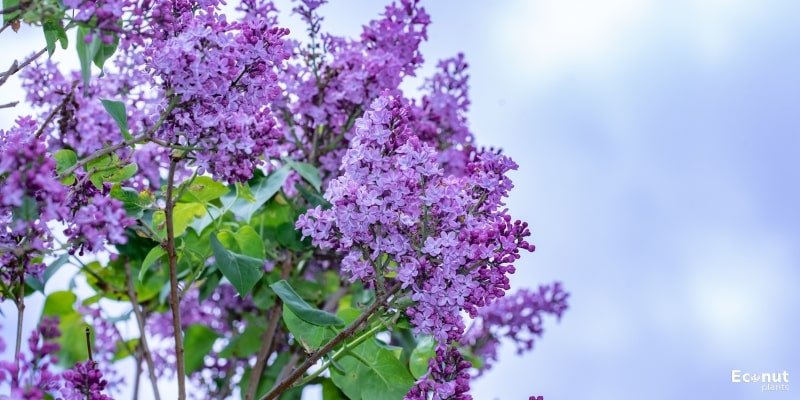
Scientific Name: Syringa vulgaris
The common lilac shrub’s dazzling purple or lavender blossoms, which open and spread their fragrance, signal the arrival of spring. Not only are these shrubs gorgeous, but they are also incredibly hardy—hardy to zones 3–7—and easy to maintain. The lilac shrub can also be used as a natural hedge, windbreak, screen, or to draw in wildlife like butterflies.
7. Purple Glory Tree
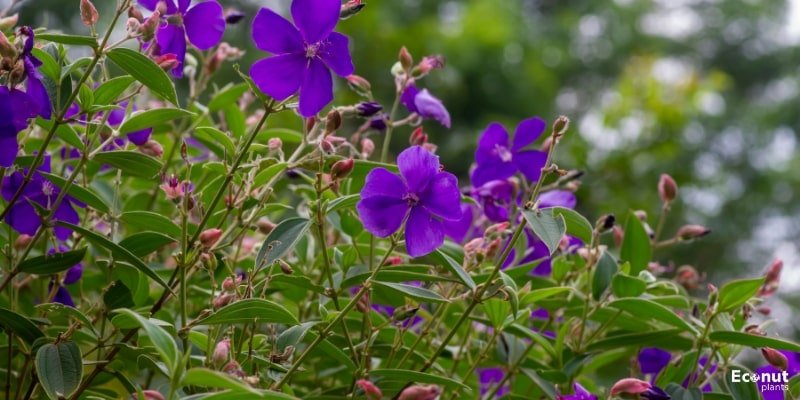
Scientific Name: Tibouchina granulosa
The purple glory tree is an elegant, bushy, tropical tree that is well-known for its lovely violet-purple blossoms, which have five petals. The tree’s canopy is covered in gorgeous purple blooms that provide a year-round, vivid show. The glossy, dark green lanceolate leaves provide a striking contrast to the enormous, velvety blooms. Its unusual purple blossoms give landscapes a hint of the tropics.
Warm, tropical climes are the ideal conditions for the purple glory tree. It grows best in soil that is well-drained, organically fertile, and damp. However, in the hottest parts of its growing zone, it requires some protection from the afternoon heat.
In warm climates, the purple glory tree is incredibly versatile. It can be grown against a wall as an espalier or as a specimen tree. As an alternative, the shrub-like tree with purple flowers can spread out like a vine over a trellis or arbor. Because of its adaptability, it’s perfect for use in containers or mixed shrub borders.
8. Korean Lilac Tree

Scientific Name: Syringa pubescent
If you’re in a less tropical area and adore the enchanted jacaranda flowers, the Korean Lilac Tree is a better choice. At about 10 feet tall, it is much smaller than the Jacaranda, but in the spring, a few weeks after other lilacs, it erupts with tubular, lavender-pink flowers.
It thrives in USDA hardiness zones 4 through 8, where it can withstand bitter cold and even salt from the road. Your Korean Lilac Tree is quite easy to care for as long as it gets full light and occasional rain.
9. Purple Leaf Plum
Scientific Name: Prunus cerasifera ‘Krauter Vesuvius
This deciduous tree blooms profusely in the spring with vivid, light pink flowers. Not only does this amazing tree have amazing dark purple foliage, but it’s also the perfect little accent tree for color.
We like to place them in front yards since they will get the appropriate kind of attention. To elegantly flank driveway entrances and gateways, we may also plant them in pairs. To provide an amazing privacy screen, they can also be planted in an orchard-like row. Regardless of how we decide to plant them, these decorative trees can create a striking and lovely color statement!
10. Eastern Redbud Trees
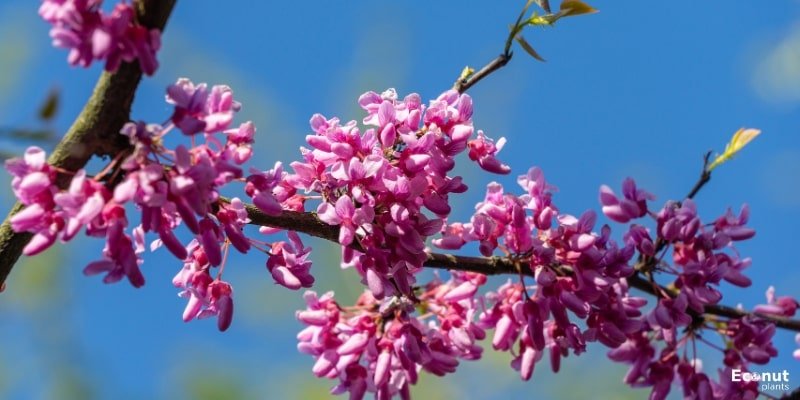
Scientific Name: Cercis canadensis
Eastern redbud trees are purple-flowering trees that bloom in the spring but do not get very big. Though their blooming period is brief, it is rather striking.
11. Purple Lily Magnolia Tree
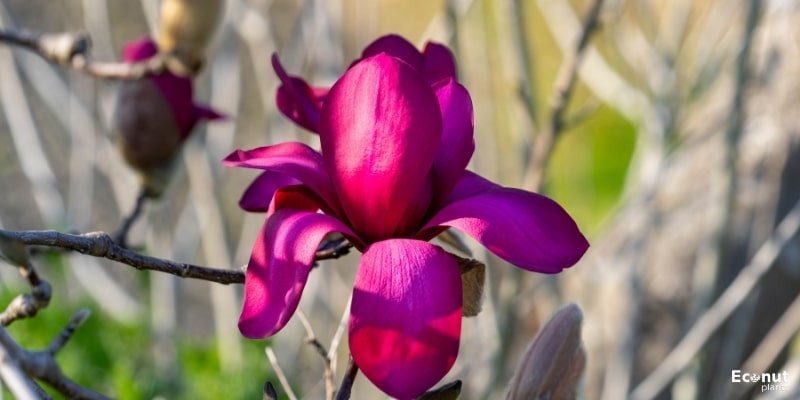
Scientific Name: Magnolia liliiflora
The Americas, East Asia, and the Himalayas are home to about 240 different species of magnolia trees. Native to the United States, species such as Sweetbay Magnolia, which bears white flowers, range from the east coast to the south. Nonetheless, a native of Asia is the Purple Lily Magnolia, which has pink blossoms.
Comparatively speaking, the tree is smaller and the blossom has a more compact appearance than other magnolias, which can reach heights of 60 feet. As a result, it’s ideal for growing in your backyard as a specimen plant or hedge.
12. Saucer Magnolia
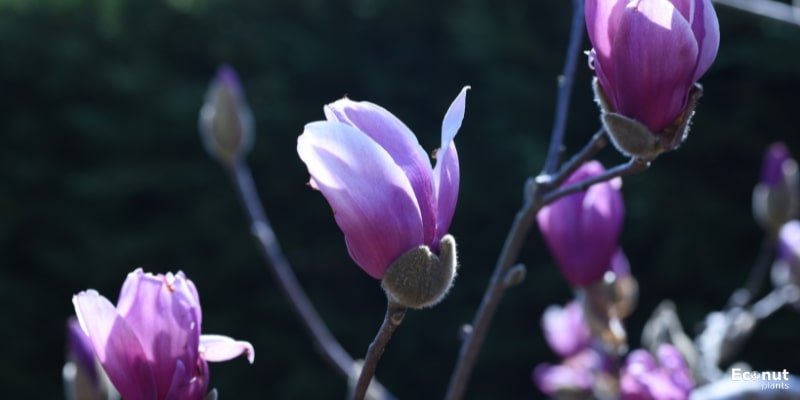
Scientific Name: Magnolia X soulangeana
Delicate saucer-shaped blooms are produced by these stunning purple flowering trees. They come in shades of pinkish-purple.
13. Purple Lily Magnolia
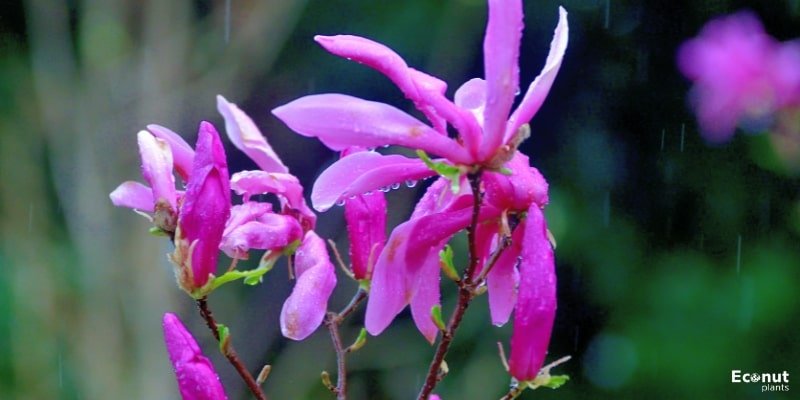
Scientific Name: Scientific Name: Magnolia Teleflora
This Purple Lily Magnolia is very different from the other Magnolias on this list while having the same name as its relative, the Magnolia tree. It produces stunning white blooms with purple undertones that, when in bloom in the spring, make a very lovely backdrop.
As they get older, they prefer acidic soil and frequent watering; later, they just need deep watering on occasion when needed. They grow best in USDA hardiness zones 5 through 9, and cuttings from older trees can be used to establish new trees.
14. Dwarf Korean lilac

Scientific Name: Syringa meyeri ‘Palibin’
Gertens Garden Center reports that spectacular purple and pink flowers are produced by the dwarf Korean lilac (Syringa meyeri, ‘palibin’). Its maximum height is seven feet, and its maximum spread is four feet.
The deep green leaves that the tree bears provide a striking contrast to the violet buds that open into magnificent blooms in late April. Though it needs to be outside in full light, it thrives in both wet and dry conditions. Horticulture states that this plant is hardy in zones 3 through 7. It has a thirty-year lifespan if
15. Purple Robe Black Locust
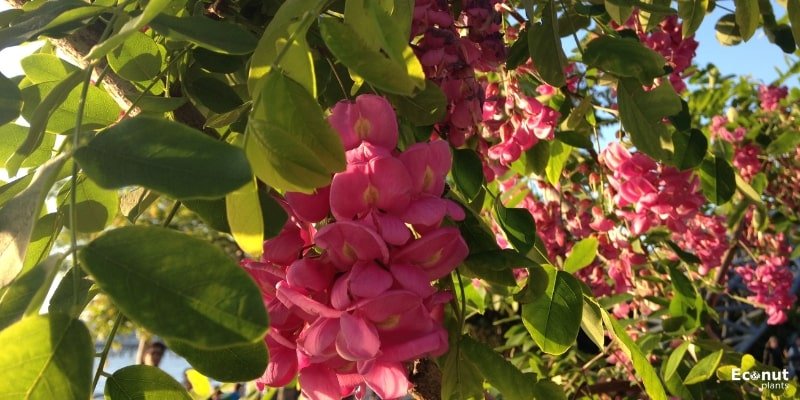
Scientific Name: Robinia pseudoacacia
Butterflies and bees love the Purple Robe Locust tree. It grows well in less-than-perfect conditions and boasts aromatic clusters of deep pinkish-purple blossoms. properly cared for.
16. Judas Tree

Scientific Name: Cercis siliquastrum
The Judas tree is attractive in the Redbud family. It is distinguished by bright clusters of purplish-rose blooms. Early spring sees the pea-like flowers blossom, enveloping the rounded, spreading crown. Bronze-red in late spring, heart-shaped leaves become yellow in the fall. Reddish-purple seed pods also hang from branches and remain all winter.
Judas trees are often planted as decorative plants because of their lovely shape, glossy leaves, and eye-catching blossoms. While they can withstand a variety of soil types in sunny areas, Judas trees prefer well-drained soil.
The Judas tree can be used as a specimen tree, a bordering blooming tree, or a patio shade tree in landscaping. The Judas tree, which is native to the Mediterranean region, is visually appealing due to its unusual seed pods and eye-catching purple blossoms.
17. Purple Flowering Crabapple Trees
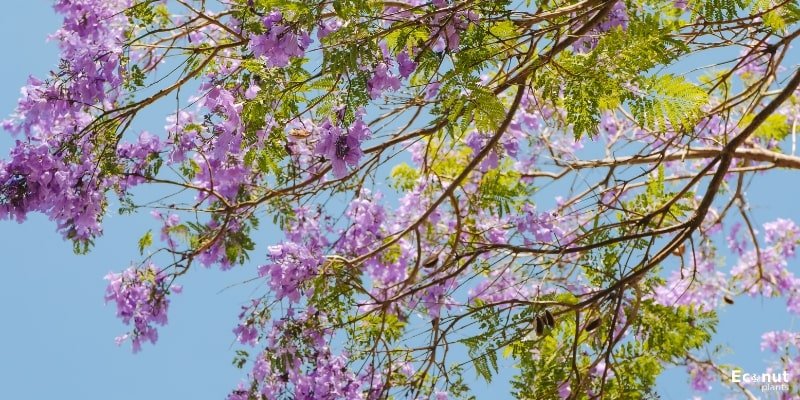
Scientific Name: Malus ‘Purple Prince
This tree has scant, rosy pink blooms in late May to early June and dark green-purple foliage all year round. The purple fruit, which peaks in early to mid-fall, can be preserved for jelly or jam. This tree should be planted at least five feet away from foundations due to its medium growth rate of 12 to 14 inches per year.
18. Silk Floss Tree

Scientific Name: Ceiba speciosa
The silk floss tree, sometimes called Chorisia speciosa or the floss silk tree, is a deciduous tree that is indigenous to South America’s tropical and subtropical woods. Even on older trees, its strong, spiky trunk maintains its green colour.
It can reach a height of 50 feet. The branches have spines and are green while they are young. However, they frequently turn grey and lose their spines. After growing quickly for a few years, the tree starts to grow more slowly.
19. Purple Orchid Tree

Scientific Name: Bauhinia Purpurea
The Purple Orchid Tree, also known as the Butterfly Tree, bears fragrant magenta blossoms that are three to five inches in size and are evocative of butterflies. Its leaves are heart-shaped, and depending on how it is pruned as it ages, it can grow large and branched or shrink and weep.
The Purple Orchid Tree grows extremely well in a container, either indoors or outdoors, in contrast to certain other trees on this list that require firm ground placement to flourish. If you want to grow the tree in a pot, seek out one that is about 16 inches wide and 14 inches deep until you see how huge it will grow. Smaller pots mean tighter roots, which keep the tree small.
20. Purple Wisteria Tree

Scientific Name: Wisteria Sinensis
The purple wisteria tree is a drought-tolerant, compact, fast-growing, low-maintenance woody vine that blooms profusely and persistently in the middle of spring.
The blossoms grow in huge, drooping clusters and might be rose, white, pink, blue-purple, or white. The tree can reach heights and widths of 10 to 15 feet, and its pinnately compound leaves can have up to 19 leaflets.
21. Chaste Tree

Scientific Name: Vitex agnus-castus
As with the first species on our list, the second species is a bit of a misnomer when it comes to purple blossoms. A fast-growing shrub in the Verbena family, the Chaste Tree (Vitex agnus-castus) is not a tree.
With blue and violet blooms that bloom from early summer to early fall, these tree-like shrubs have grayish-green, palm-shaped leaves that smell almost as good. In full bloom, the Chaste Tree attracts hummingbirds, butterflies, and other pollinators.
Well-draining, dry soil is ideal for chaste trees. You won’t typically need to water it once it is established. Plus, this tree benefits more from inferior soil. They even accept a small amount of salt off the road! Ensure that they receive an appropriate amount of direct sunshine.
22. Hibiscus Tree

Scientific Name: Hibiscus syriacus
The Hibiscus syriacus, sometimes referred to as the Rose of Sharon, is a multi-stemmed shrub that can be cultivated into a tree. However, certain cultivars, such as the Purple Pillar, grow in a single vertical column by nature. The stunning violet blooms, which endure only a single day from midsummer to autumn, are a favourite habitat for hummingbirds and butterflies.
With full sun and well-draining soil, hibiscus trees thrive in USDA hardiness zones 5 through 9. Natural resistance to deer, drought, and even salt is ingrained in them. Certain types, like Purple Satin, yield sterile seeds, but they can still be grown from cuttings and reach heights of up to 12 feet.
23. Lavender Twist
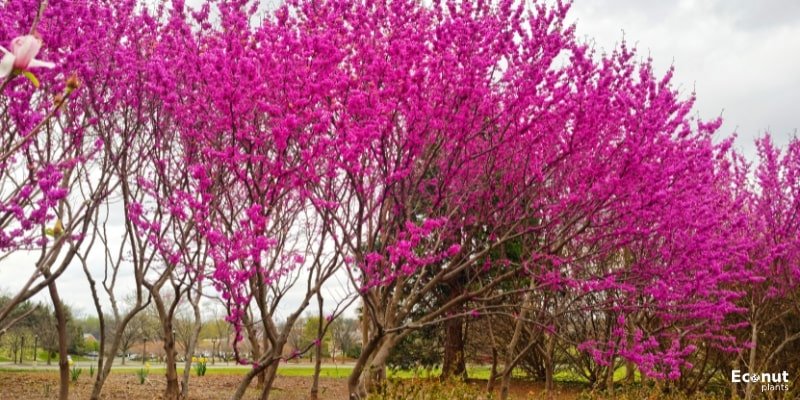
Scientific Name: Cecis Canadensis ‘Covey’
This magnificent weeping tree is related to the common Eastern Redwood, as its botanical name indicates. This one is especially unusual because of the way its cascading branches bend and twist to form a twiggy canopy covered in lavender-pink blossoms. However, it stays quite short, which is ideal for cramped areas.
USDA hardiness zones 5 through 9 are ideal for growing lavender twists. They like full sun, consistent watering, and a yearly feeding of food made from trees and shrubs. The plethora of butterflies and birds that adore these purple blooms will be your reward.
24. Mountain Laurel

Scientific Name: Kalmia latifolia
North American native rhododendrons are related to mountain laurel. Though some cultivars only reach a maximum height of about 6 feet, this little tree can reach up to 15 feet in height, making it ideal for tiny yards and tight places. In late spring and early summer, this tree erupts with pink, white, or red flowers tinged with deep crimson or purple.
USDA hardiness zones 5 through 9 are ideal for Mountain Laurel growth, and they can withstand a variety of growing environments. While they can tolerate both full sun and deep shadow, they are most comfortable in moderate shade for maximum blossoms and a reduced chance of scorching.
25. Royal Purple Smoke Tree

Scientific Name: Cotinus coggygria ‘Royal Purple’
A peculiar and striking-looking tree that never fails to leave an impression is the Royal Purple Smoke Tree. It produces flowers with fringes that resemble smoke, has dark purple foliage, and changes to a striking red in the autumn.
It is incredibly low-care, but it does require full sun and infrequent deep watering, grows well in USDA hardiness zones 4 through 8. It’s an excellent addition to northern gardens since, in contrast to many of the trees on our list, it can withstand frigid temperatures.
Conclusion
We hope you have enjoyed viewing some of our most beloved purple-flowering trees. These striking trees are perfect if you’re trying to add a unique splash of colour to your yard. In any garden, many of the trees we’ve discussed make excellent accent plants, privacy screens, and shrubs.
Remember to consider the environment in your area and be realistic about how much upkeep you are willing to give your trees to get the maximum enjoyment out of them. There’s a purple-flowering tree for every skill level of gardener, from novice to expert.


